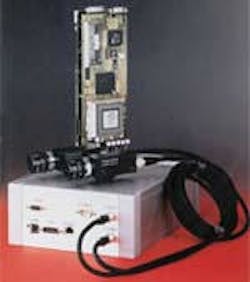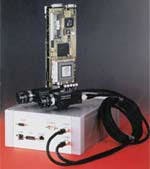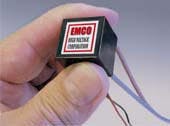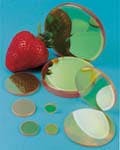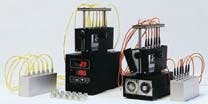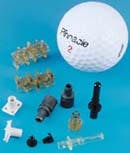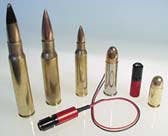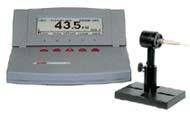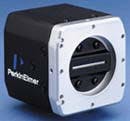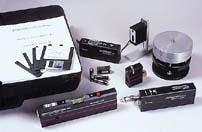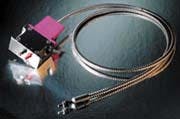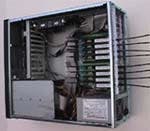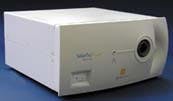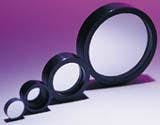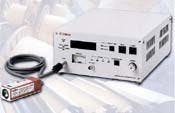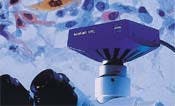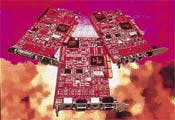New Products
PC-based imaging module
The HiPerCam 2 is an area scan camera with CCD technology and an intelligent frame grabber in a single compact box. It is designed for quality-control inspection in clothing manufacturing and for surface inspection of materials that normally require two cameras to obtain the resolution of the entire inspection area. The system can interface to more than one camera at one time. It works with many camera types, including progressive scan cameras that scan even/odd lines together to provide a single frame with full resolution.
American Eltec, Princeton, NJ
Miniature power supplies
Models Q60, Q80, and Q101 (Q60N, Q80N, and Q101N for negative output polarity) accept 0- to 5-V input and provide 0- to 6-, 8-, or 10-kV output. Utilizing a quasi-sine wave oscillator and an enclosed pot core transformer, these power supplies have low levels of EMI/RFI and output ripple <0.75%. The isolated output is proportional to the input and has a turn-on voltage of 0.7 V. These miniature converters measure 21.5 x 21.5 x 21.5 mm and weigh 28 g.
Emco, Sutter Creek, CA
CO2 lenses and windows
CO2 lenses are available from 0.6- to 2.0-in. diameter with focal lengths from 1 to 20 in. in 0.1-in. increments, depending on configuration, and in sizes up to 3.0-in. diameter for use as windows. Zinc selenide positive-focusing lenses provide <.25% total absorption values and are suited for laser systems from 25 to 200 W. The lenses are optimized for 10.6-µm laser radiation.
Laser Research Optics, Providence, RI
Fiberoptic curing ovens
The T-50V-BRC programmable curing oven is a microprocessor-based ramping control oven. Designed for both manufacturing and laboratory use, the oven has a 24-step program capability, ramp-rate (time)-base programming, guaranteed soak deviation, program looping and status selection, and nonramping set point of operation. The oven cures up to 12 connectors simultaneously. The standard T-50V curing oven has an internal thermal coupler for temperature stability and external controls for temperature and time. It is designed for laboratory, manufacturing, and field use.
The Light Brigade, Kent, WA
Laser welding system
The NanoBonder LWS System is a fully automated laser welding system for fiberoptic components. Integrating motion control, machine vision, five-axis alignment stage, and laser-weld process technology, the system offers improved throughput and yields by minimizing alignment and bonding cycle times. The AdeptWindows MV contoller platform is the basis for the expandable, configurable controller hardware architecture.
Adept Technology, San Jose, CA
Visible laser diodes
High-power laser-diode arrays of 2 to 10 W at 680 nm are delivered in standard packages for free-space and fiberoptic output. Multibeam (NN 2, 4, 8, 16) individually addressable laser-diode arrays in TO-8 packages with an integrated microcooler are available. Uses include pointing, target destination, spectroscopy, high-speed printing, and medical applications.
Frankfurt Laser, Nidderau, Germany
Laser module
The new Ranger module is designed to shut off and lock down the laser in a few nanoseconds to prevent damage from any nonscheduled event, including transients over voltage or excess currents. A new LSI chip runs on a standby current of 2.5 A and provides regulated and safety-controlled laser drive with full automatic power control via a feedback loop. Regulated output is from 2.4 to 2.6 V regardless of input voltage.
LasIRvis, Bedford, England
Megapixel NIR camera
The KP-F120 camera is a high-resolution, progressive-scan, 2/3-in. CCD camera that extends to the NIR. Camera resolution is 1.45 million effective pixels, 1392 x 1040. A frame-on-demand function allows images to be captured for viewing or processing at a selected time with a choice of three trigger modes. Applications include machine vision, agricultural inspection, medical diagnostics and research, and microscopy.
Hitachi Denshi America, Woodbury, NY
Laser-diode drivers
The PPS line of laser-diode drivers allows drive currents from 0-5 A in either cw or pulsed mode. The units have universal input, safety interlock, digital display with sample and hold capability, and come with an 18-month warranty. Custom units are also available.
Portable Power Systems, St. Louis, MO
Broadband EDF source
The new broadband erbium-doped fiber (EDF) source is an economical benchtop unit providing more than 10 mW in fiber in the 1525 to 1565-nm range. The standard version uses a 980-nm pump scheme with front panel controls to allow continually variable pump powers up to 70 mW. The source output is optically isolated and available from a panel-mounted FC/ACP connector.
LG-Laser Technologies, Kleinostheim, Germany
UV laser
The Model 210UV laser has specified UV outputs of greater than 9, 8, and 6 W at 20-, 40-, and 60-kHz pulse repetition rates. Pulse-to-pulse stability is typically <0.5% rms. Incorporating patented DCP and SURE technologies, higher power is achieved by optimizing the thermomechanical design. The laser was designed for UV microvia drilling and other micromachining applications.
Lightwave Electronics, Mountain View, CA
Focusing element nanopositioner
The Nano-F100 is a focusing element nanopositioner with subnanometer accuracy under closed-loop control. Designed as an alternative for z-motion in microscopy applications, it can be used as a stand-alone item or in conjunction with other nanopositioning systems. The device is constructed from aluminum and includes piezoresistive sensors for absolute position measurement. Total range of motion is 100 µm.
Mad City Labs, Madison, WI
Core-pitch measurement instrument
The Model FZ-1000XD-S incorporates a high-power illumination system and 100X optical microscope with XYZ stage for noncontact measurement of fiberoptic arrays, MT ferrules, and V-groove blocks. The instrument has an image resolution of 0.07 µ and a positional repeatability of 0.3 µ. Automated measurement software uses an icon-based Windows interface.
Moritex Europe, Cambridge, England
Picowatt laser-power meter
The model PD300-IRG InGaAs power meter, with a noise level of 100 fW, is designed for making precision measurements for fiberoptic communication applications. The power meter has a spectral response range of 800 to 1700 nm. The power meter head has a built-in optical collimator, a removable filter for measurements up to 300 mW, a 3.5-mm aperture for direct beam measurement, and both an FC and LC fiber adapter.
Ophir Optronics, Danvers, MA
Digital linescan camera
The LD3500 Series digital linescan camera has resolutions of 512, 1024, and 2048 pixels and data rates of 20 or 40 MHz. The camera series features a 14-µm2 pixel linear CCD, CameraLink and Parallel LVDS video-output models, 8-bit output depth, antiblooming control, single power-supply operation, and linescan rates to 66 kHz. The camera measures 2.5 x 3.2 in.
PerkinElmer Optoelectronics, Fremont, CA
Deep-blue DPSS laser
The new 58 BTL series of diode-pumped solid-state (DPSS) lasers operates at 430 nm with a single longitudinal mode, producing low-noise, single-frequency output with <2% peak-to-peak noise. The lasers are available with output powers of 5 or 8 mW. The beam is nearly circular (1.25:1 aspect ratio), linearly polarized, and has an M2 factor <1.3. The compact, conduction-cooled laser head incorporates thermoelectric cooling and automatic power control. Applications include fluorescence and Raman spectroscopy, confocal microscopy, DVD mastering, and long-path-length holography.
Melles Griot, Carlsbad, CA
Alignment kit
Alignment kits have been introduced for use with the Laser Microgage 1000 laser transmitter and digital receiver system. Measurement and alignment readings from 1/4 in. down to 0.00001 in. can be made over ranges from a few inches to 80 ft. or more. The kits are designed for measurements of straightness, flatness, squareness, parallelism, and the leveling of machinery in the metalworking, plastics, manufacturing, and processing industries. Add-on modules are available.
Pinpoint Laser Systems, Newburyport, MA
Microscope-objective nanoscanners
P-722/P-723 PIFOC microscope-objective nanopositioners have 1-nm resolution, travel up to 350 mm, precision trajectory control, and can be mounted on almost any microscope. A variety of analog and digital piezo controllers are available to run the units. Applications include confocal microscopy, near-field microscopy, scanning interferometry, and surface structure analysis.
Polytec PI, Auburn, MA
Forensic kit
A forensic kit has been specifically developed for the examination of fingerprints treated with fluorescent stains. The kit includes a portable light source with a 250-W halogen bulb, a fiberoptic light guide, excitation and barrier filters, and goggles. Excitation light can be switched between white, blue, and green using an integrated filter wheel. The kit can be used at the crime scene and in the laboratory.
Schott-Fostec, Auburn, NY
30-W fiber-coupled semiconductor laser
A new 30-W fiber-coupled semiconductor laser at 980 nm is designed for medical, therapeutic, and surgical applications. The laser device is available at fiber bundle diameters of 852 (with optional aiming fiber) and 825 µm (without aiming fiber) and delivers more than 80% of its rated power within a 0.12 NA. The device couples to surgical fibers of 300 µm and larger diameters, using commercially available optics.
Spectra-Physics, Mountain View, CA
IR thermometer
The Pyrofiber fiberoptic, noncontact, automatic emissivity-correcting IR thermometer has been upgraded to incorporate a single digital and two analog outputs. Users can output both emissivity values and emissivity-corrected temperature values directly to their furnace process control or PLC. The instrument uses patented pulse-laser technology.
Pyrometer Instrument, Northvale, NJ
Optical glass for low-temperature molding
K-PG375/Vidron is a new optical glass for precision molding at ultralow temperatures, ranging from 370°C to 375°C. The glass has a nd of 1.54250, vd of 62.9, ne of 1.54455, ve of 62.5, a transformation point of 343°C, and a thermal expansion of 169 x 10-7. Complicated products such as aspheric lenses with holograms, fly-eye lenses, microlens arrays, and fiberoptic arrays can be molded.
Sumita Optical Glass, Saitama, Japan
8-channel spectrometer
The SSRack 8-channel spectrometer system features eight independent fiberoptically coupled spectrometers operating in parallel. Each channel contains a separate detector and associated digitizer with scan memory for simultaneous measurement. The instruments are installed inside a 700-MHz industrial computer with a 100-Mbit network interface and include a 20-Gbyte hard drive with keyboard, monitor, and USB ports.
StellarNet, Tampa, FL
Deep-UV microscope
The DUV-250i is an inverted real-time DUV microscopic imaging system that combines proprietary advancements in optics and mercury arc illumination to achieve 25,000X magnification. This system was designed to fill a gap between visible light and scanning electron microscopy. The DUV-250i allows for quick inspection of semiconductor samples during preparation. Tripod mounting samples can be polished just up to the specified submicron feature, avoiding overpolishing.
TNP Instruments, Carson, NV
Camera for electron backscatter diffraction
The DigiView 1612 is a new high-resolution, high-speed CCD camera for electron backscatter diffraction (EBSD) and orientation imaging microscopy (OIM). Maximum image resolution is 1300 x 1030 pixels with 12-bit dynamic range. Indexing speeds of up to 50 points are achieved by integrating fast EBSD indexing algorithms intimately with the camera and read-out software. This permits the collection of crystal orientation maps of 25,000 points in 10 min.
TSL, Draper, UT
100-W xenon fiberoptic illuminator
The ST-100 is a 100-W xenon fiberoptic illuminator designed for medical OEMs to integrate into endoscopic systems. The illuminator is based on a proprietary double-mirror optical system to project bright, white light through 1- to 2-mm-diameter plastic or glass fibers. The illuminator consists of a 140 x 260 x 286-mm metal casing that houses a 100-W xenon bulb, control electronics, and cooling components. The unit is powered by 100~240-V ac and has a 1000-h lamp life.
WelchAllyn, Skaneateles Falls, NY
Filters for 157-nm semiconductor applications
VUV neutral density filters optimized at 157 nm are available for laser-beam attenuation applications, including protection of monitoring systems and detectors from intense VUV radiation and control of beam intensity in exposure systems. Optical densities from 0.3 to 6.0 at 157 nm are available. A 157-nm narrowband filter for F2 lasers is also available. Offering 12% minimum transmission at 157 nm, with maximum bandwidth of 36 nm, they are produced on VUV grade CaF2 substrates up to 2.0-in. diameter.
Acton Research, Acton, MA
Electronics for UV-sensitive CCDs
Preamplifier electronics for the series S-703x UV-sensitive CCD sensors from Hamamatsu have been introduced. Using a space-saving modular design, the compact spectrometer has a low split-off angle. A separate power-supply board takes all of its required voltage from its 12-V dc output. An optional temperature-control board for the integrated cooler is available. Various binning modes are supported.
Tec5, Oberursel, Germany
Optically clear epoxy adhesive
TRA-BOND F113 is a very-low-viscosity epoxy designed for bonding, laminating, sealing, and small-volume potting of glass, plastics, ceramics, and metals. The epoxy has a pot life of 2 h and cures at room temperature. The high-impact bonds are suitable for bonding lenses, prisms, LED displays, and other optical applications where clarity is needed.
Tra-Con, Bedford, MA
Laser Doppler velocimetry sensor
The new miniature S-100Z laser Doppler velocimetry sensor is designed for measuring movement velocity of solid objects, powders, and fluids. The sensor measures velocities of moving substrates from -12 to 120 m/min. The system includes a miniaturized optical sensor, a signal-processing unit, and a 680-nm semiconductor laser. The system uses a noncontact laser-beam measuring technique for detection precision of ±0.1%(FS). Resolution for the sensor is available in 2.5, 5, 10, 20, 40, 80, 160, and 320 m/pulse.
Canon U.S.A., Lake Success, NY
Digital camera
The new AxioCam MR digital color camera uses a 12-bit digitization process for improved image and color quality. A 36-bit color depth allows for a large number of resolvable brightness graduations. Variable exposure times accommodate different application techniques. The AxioCam MR monochrome version is designed for fluorescence microscopy, particularly in applications with long exposure times. Applications include pathology, neuroscience, cytology, zoology, and botany.
Carl Zeiss, Thornwood, NY
Optical character verification/recognition tools
The In-Sight line of vision sensor products has added optical character verification (OCV) and optical character recognition (OCR) software tools. The OCV tool is used to verify the correctness and legibility of printed characters. The OCR tool will enable companies to improve product traceability by automatically reading alphanumeric codes on a wide range of items. Both tools include a graphical font training utility.
Cognex, Natick, MA
DPSS cw green laser
The Compass 215M is a 15-mW diode-pumped solid-state (DPSS) cw laser that emits at 532 nm. The laser has been specifically designed as a green laser source for the bioinstrumentation and photofinishing markets. The laser incorporates Coherent's proprietary Permalign manufacturing technique, in which every component within the laser head is aligned with external tooling and then soldered into place.
Coherent, Santa Clara, CA
Monochrome frame grabber
The Bandit-II MV is a monochrome frame grabber with an integrated VGA display for AGP and PCI Bus. It provides OEM products with real-time control of operations such as I/Os, frame stamping, trigger, strobe, and exposure control. The frame grabber captures from single- or dual-scan analog cameras at sampling rates of up to 40 MHz for monochrome or 30 MHz for RGB cameras.
Coreco Imaging, Bedford, MA
UV cure adhesive
A moisture-resistant UV light cure adhesive has been introduced for optical pathway bonding applications and for photonic devices. Hysol UV 702 is a low-viscosity acrylic material that can wick into and fill small gaps of less than 25 µm. The material forms an impact-resistant bond between transparent parts and surfaces, including quartz, silicon, ceramic, and some plastics.
Dexter, Olean, NY
Spectral imaging system
The PARISS (Prism and Reflector Imaging Spectrometer System) wavelength-dispersive spectral imaging system acquires all wavelengths simultaneously. Smart algorithms then generate a spectral topographical map over an unlimited field of view. Submicron objects can be characterized as a function of the subtle changes in fluorescence, transmission, or absorption. The system is designed for characterization of defects, pH, FRET, and FRAP.
LightForm, Hillsborough, NJ
